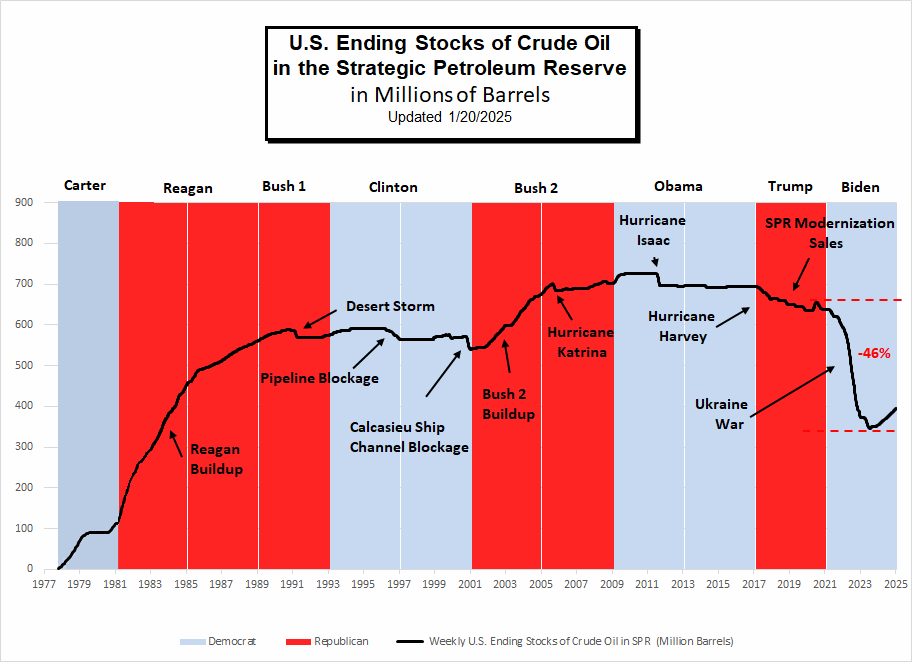In his 2025 inauguration speech, Donald Trump emphasized the importance of the Strategic Petroleum Reserve (SPR) and national energy independence. He promised to “drill baby drill” and “bring prices down, fill our strategic reserves up again, right to the top, and export American energy all over the world.”
According to Energy.gov, the “top” of the Strategic Petroleum Reserve is 714 million barrels. When Trump left office in 2021 the reserve was at 638.086 million. That was down from its peak because Congress sold off some of the oil to pay for the modernization of the SPR. By July 2023 Biden had drawn the reserve down 46% to 346.759 million before stopping the drawdown and beginning a gradual refill. As of January 2025, the SPR is at 394.317 (i.e. down 38.2% from Trump levels or 44.7% from full). So, the SPR has a long way to go before it gets refilled.
Strategic Petroleum Reserve Data: eia.gov
How Can Trump Drive Oil Prices Down AND Fill the SPR?
At first glance, it would seem that driving oil prices down and simultaneously filling the SPR would be mutually exclusive. After all, Biden drained the SPR in an effort to drive oil prices down. So, how can Trump fill the Strategic Petroleum Reserve AND still keep oil prices low? The answer can be found on the previously mentioned Energy.gov page.
“In February 1999, the Clinton Administration announced a new plan to resume fill of the Strategic Petroleum Reserve with federal royalty oil from production in the Central Gulf of Mexico… From 1999 through December 2009, the SPR accepted royalty-in-kind transfers of crude oil as a primary means of acquiring oil for the SPR.”
If oil companies want to drill on Federal lands they have to pay royalties to the Federal Government. Back in 1999, the Clinton administration sold drilling rights to drill in the Gulf but rather than accepting payments in cash they accepted “payment in kind”. So, if Trump is going to “Drill Baby Drill” he can use the same method to fill the SPR. The companies will produce more oil (which will drive the price down) and simultaneously send a portion of the new oil to the SPR.
In May of 2001, President Bush used the same method to bring the SPR up to full capacity. Sometimes oil companies needed to defer deliveries to the SPR. In those cases, the Energy Department would charge “interest” in the form of additional oil to be delivered at a later date to the SPR.
Interestingly, during Trump’s first term, Congress fought his attempt to refill the SPR, claiming that it would be too expensive. In actuality, it is simply a matter of writing lease terms properly. And, if the government had nimble traders, they could have bought oil for less than nothing on April 20th, 2020, when COVID temporarily drove the price of crude into negative territory for the first time in history. See: How Can Oil Be Worth Less than Nothing? and a month later Oil was still only $35/ Barrel. Oil Goes from Zero to $35 in a Month. In hindsight, Congress’ anti-Trump stance cost them an opportunity to refill the SPR at historically low prices. And those low prices caused many small producers to go out of business, which combined with Biden’s anti-oil stance, resulted in the high oil prices that Biden drained the SPR to curb.
